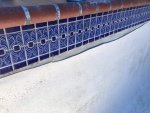Hi All,
I am in the process of refinishing my pool, a 15k gallon gunite pool that was fiber glassed 12 years ago with new tiles and copings. I have not been good with its chemistry just like my chemistry in college, so now I have a lot of calcium build up on the tiles and many areas of the pool. Currently cleaning the tiles and noticed patches of the fiberglass where it meets the tiles are starting to delaminate. I am cutting away sections that are loose and will be replacing them. The problem I have is that the fiberglass where it meets the tile are super thin around 1/16" or less but a few inches below is around 1/8 inch. Overall the fiberglass walls and bottom surfaces are strong and stable. Do you guys think that I can cut a slot 1/4 x 1/4 along the bottom of the tile so I can have some fiberglass thickness to the edge of the fiberglass? I am hoping with a thicker edge and more surface adhesion will prevent delaminate, or at least last longer. Do any of you think it will weaken the pool's stucture grinding a grove?
Here are some pictures.



I am in the process of refinishing my pool, a 15k gallon gunite pool that was fiber glassed 12 years ago with new tiles and copings. I have not been good with its chemistry just like my chemistry in college, so now I have a lot of calcium build up on the tiles and many areas of the pool. Currently cleaning the tiles and noticed patches of the fiberglass where it meets the tiles are starting to delaminate. I am cutting away sections that are loose and will be replacing them. The problem I have is that the fiberglass where it meets the tile are super thin around 1/16" or less but a few inches below is around 1/8 inch. Overall the fiberglass walls and bottom surfaces are strong and stable. Do you guys think that I can cut a slot 1/4 x 1/4 along the bottom of the tile so I can have some fiberglass thickness to the edge of the fiberglass? I am hoping with a thicker edge and more surface adhesion will prevent delaminate, or at least last longer. Do any of you think it will weaken the pool's stucture grinding a grove?
Here are some pictures.




